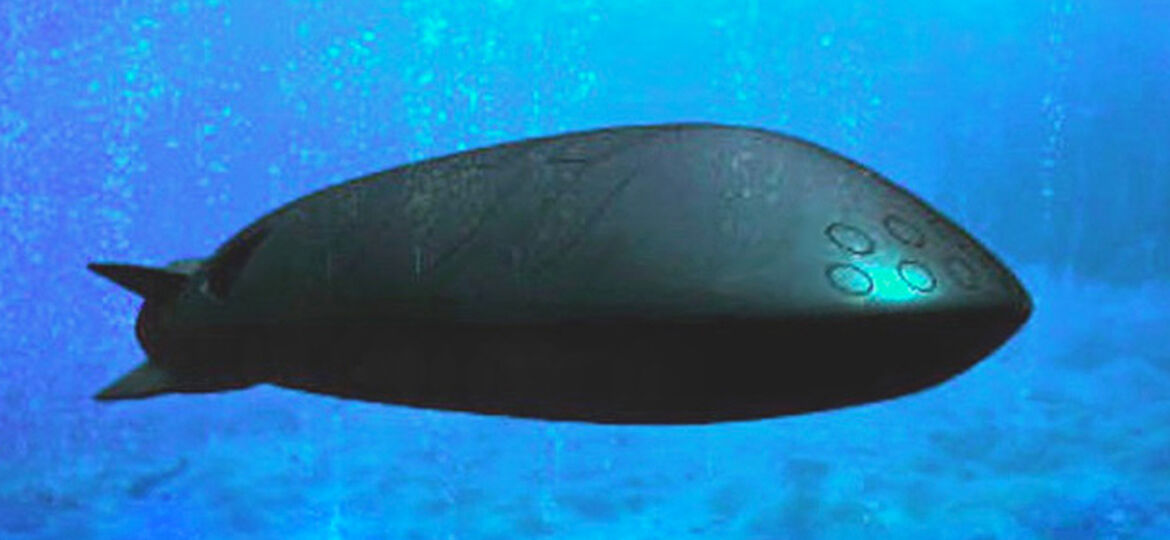
WHY THIS MATTERS IN BRIEF
- A collection of new emerging, and advanced technologies, combined with a new political landscape are helping nation states refashion their war machines and society should not be complacent about the implications
After an apparent leak by a Russian news outlet it has emerged that Russia has been testing a “terrifying new autonomous drone submarine” capable of carrying nuclear warheads in waters off of the US East coast.
The top secret nuclear capable sub, code named “Kanyon” by the Pentagon, allegedly has a displacement of 40 tonnes, a range of up to 6,200 miles and a top speed of 56 knots. US security officials say that they first detected the test of the new system on November 27 after it was launched from a Sarov class submarine – although they didn’t reveal the location.
The drone submarine is further evidence of what US officials say is an “aggressive Russian strategic nuclear forces modernization program” and officials familiar with details of the Kanyon program said the weapon is envisioned as an autonomous submarine first strike vehicle that can be armed with nuclear warheads that range in size to “tens” of megatons – one megaton alone having a destructive power dozens of times that of the Hiroshima and Nagasaki atomic bombs.
When sat atop missiles megaton warheads are often called “city busters” because they are designed to destroy entire metropolitan areas or blast buried targets and an underwater megaton-class drone weapon could be used to knock out harbours and coastal regions, said officials who declined to be named due to the sensitivity of the information.
“This is an unmanned sub that will have a high-speed and long-distance capability,” said one official, who noted that the drone development is years away from being deployed.
The existence of Kanyon will no doubt further complicate the US’ own nuclear strategy.
“It’s very difficult to consider Russia a responsible party when it’s developing something like this,” the official said.
Another official familiar with the program said that the Kanyon will be a large nuclear-powered autonomous submarine. This official said the size of its nuclear warhead is not clear.
Russian leaders announced their new maritime strategy in July and provided hints about the new drone sub, based on a doctrine that calls for the development of new innovative technologies – including unmanned underwater vehicles.
Lt. Col. Michelle Baldanza, a Pentagon spokeswoman, declined to comment on the nuclear-armed underwater drone.
The Pentagon said last week that it is closely watching a Russian military research ship that sailed along the east coast of the US, the ship, a research vessel called the Yantar, was engaged in underwater reconnaissance, gathering intelligence that could be used to support a weapon system like the nuclear UUV.
While the US currently has no similar plans for a megaton-class underwater nuclear strike vehicle the US Navy is developing a range of UUVs – including a weapons carrying drone.
“The Kanyon represents another example of Russia’s aggressive and innovative approach to the development of military capabilities against US and Western interests,” said Jack Caravelli, a former CIA analyst who specialized in Soviet and Russian affairs.
“The possible yield of the warhead, in the megaton class, clearly is an attempt to inflict catastrophic damage against US or European naval facilities or coastal cities,” he added, “nations vote with their resources, and the Kanyon, along with an expanding number of other military modernization programs, indicates the priority Vladimir Putin places on military preparedness against the West.”
Meanwhile Mark Schneider, a former Pentagon nuclear policymaker, said Russian state run media, such as RIA Novosti, as well as a string of Russian weapons engineers have continuously announced plans for more UUV development.
“In 2014, Putin stated that there were undisclosed strategic nuclear modernization programs that would be made public at the appropriate time,” said Schneider, “and this might be one of those announcements.”
“Our institute already concluded a number of new developments in the sphere of command systems automation [including] remotely operated, unmanned sea based underwater vehicles. We hope that these developments will be applied for designing of a new destroyer vessel,” said Lev Klyachko, director of the Russian Central Research Institute.
Robert Kehler, who retired two years ago as commander of the US Strategic Command, said development of a robot underwater nuclear strike vehicle could be part of what he termed a “troubling” Russian strategic nuclear buildup.
“Overall, we were watching the Russian nuclear modernization effort very carefully,” said Kehler.
Norman Polmar, a naval analyst and author, said the Kanyon could be based on a Soviet era nuclear torpedo disclosed in his 2003 book, “Cold War Submarines.”
Both the Russian Navy and its Soviet predecessor, have been innovators of undersea systems and weapons.
“These efforts have resulted in some of the world’s most advanced torpedoes,” said Polmar, “early in the nuclear age, the Soviets began development of a massive torpedo for attacking coastal cities and ports.”
The T-15 torpedo was about 75 feet long and was capable of carrying a high-yield thermonuclear warhead some 15 miles underwater, something Polmar called “a truly innovative concept.”
“While unmanned technology itself is not new, the potential impact these systems will have on the way we operate is almost incalculable,” said Ray Maybus, US Navy Secretary in a speech in April.
Russia aren’t alone in their pursuit of the development of new drone UUV’s though, there are a flotilla of countries prioritising the tech, including the US, but at the moment it looks like Russia are the only ones who are developing a first strike UUV weapon. If history teaches us anything though it’s that where one country leads others will follow…

















[…] drones and robots – many of which, such as the USN Zumwalt and Russia’s latest nuclear capable drone submarine, which the Pentagon recently found flexing its smarts off of the East coast of the US, as well as […]